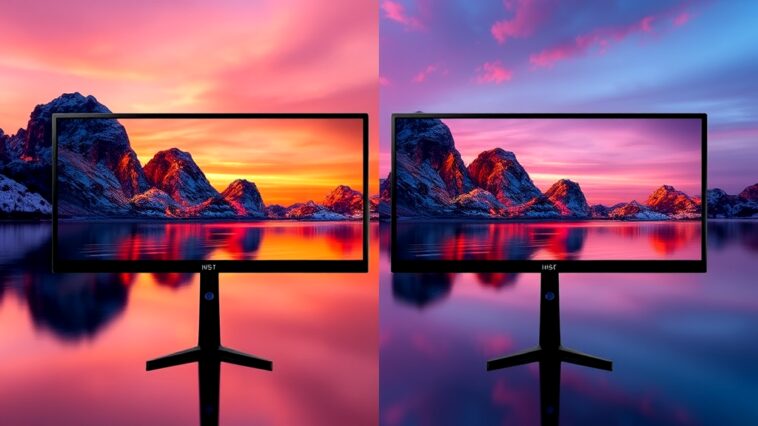When it comes to choosing the right monitor for color-critical work, the battle between IPS (In-Plane Switching) and OLED (Organic Light Emitting Diode) displays is one that stirs up a lot of debate among graphic designers, photographers, and video editors. With advancements in technology, these two display types have become popular for their unique benefits and drawbacks, especially in the realm of color accuracy. So, let’s dive right in, shall we?
Understanding IPS and OLED Technologies
First, a quick primer on what these technologies actually are.
IPS Panel Technology
IPS monitors have been around for a while. They are known for their wide viewing angles and excellent color reproduction. The color accuracy in IPS displays comes from the way the liquid crystals are aligned in the panel. This technology allows for better color consistency across different viewing angles. So, if you’re sitting off to the side, you won’t see a significant shift in color, which, let’s be honest, is a big deal when you’re doing any sort of color-sensitive work.
OLED Display Technology
On the other hand, OLED technology has taken the display world by storm. Each pixel on an OLED display emits its own light, which means that there’s no need for a backlight. This results in deeper blacks and a superior contrast ratio. The colors on OLED monitors are often described as vibrant and dynamic, which can make images pop in a way that IPS displays sometimes struggle with. But then, you might be wondering—does that mean OLED is the clear winner? Hold that thought.
How Color Accuracy Differs Between IPS and OLED Displays
When we talk about color accuracy, we’re really looking at how well a monitor can reproduce colors as they are intended to be seen. This involves several factors, including color gamut, hue accuracy, and brightness levels.
Color Gamut
The color gamut refers to the range of colors that a display can reproduce. IPS monitors typically cover a wider color gamut than traditional displays, making them ideal for tasks like photo editing. But, OLEDs often exceed this with their ability to produce rich, saturated colors that can sometimes leave IPS in the dust.
Hue Accuracy
Hue accuracy is another critical metric. This measures how accurately a monitor can reproduce specific colors. IPS panels generally excel in this area, especially when it comes to skin tones and natural colors. But, OLEDs can sometimes over-saturate colors, which might not be ideal for professionals needing pinpoint accuracy.
Brightness Levels and Contrast Ratio
When it comes to brightness, IPS monitors usually perform well, but OLEDs can achieve higher brightness levels with better contrast ratios. This is where OLED truly shines—pun intended. The ability to display true blacks and vibrant colors can significantly enhance the viewing experience, especially in darker environments.
Real-World Color Accuracy Tests: IPS vs OLED Displays
So, what do real-world tests say? Well, studies and reviews often highlight that while OLED displays can achieve stunning visuals, there’s a risk of color shift as the display ages. Conversely, IPS monitors maintain their color accuracy over time. It’s like that friend who always shows up on time versus the one who “might” show up—reliability can be key.
Advantages of IPS Technology for Photo and Video Editing
When it comes to photo editing and video editing color precision, many professionals swear by IPS monitors. They appreciate the consistent color reproduction and wider viewing angles. For example, if you’re working on a team project, everyone can gather around and see the same colors without distortion—pretty handy, right?
Here are some specific advantages of IPS technology:
- Consistency in Color Reproduction: With IPS panels, you can expect a consistent performance across different lighting conditions, which is crucial for photo editing.
- Better Viewing Angles: This is a game-changer. If you’ve ever tried editing on a monitor that had terrible viewing angles, you know what I mean.
- More Accurate Color Profiles: Many IPS monitors come calibrated out of the box, which can save you time on calibration.
OLED Monitor Benefits for Vibrant Color Representation
However, it would be a mistake to overlook the advantages that OLED offers. Here’s why some professionals are leaning towards OLED:
- Vibrant Color Representation: OLED panels can create colors that are more vibrant and alive than anything IPS can muster. This makes them great for graphic designers who want their work to stand out.
- Lighter and Thinner Designs: OLED technology allows for thinner and lighter displays. So, if you’re someone who travels a lot, this might be a big selling point.
- True Blacks: Ever watch a movie in a dark room? OLEDs can make that experience absolutely phenomenal. The blacks are true blacks, which means better contrast and depth.
Choosing the Right Monitor for Color-Critical Work: IPS vs OLED
At the end of the day, the choice between IPS and OLED really depends on what you need. Here are some questions to ask yourself:
- What type of work am I doing? If you’re primarily editing photos, you might lean towards an IPS monitor for its color accuracy.
- Do I need a vibrant display for graphic design? If you want that pop of color, an OLED might be the better choice.
- How often am I going to calibrate my monitor? Some users find OLEDs require more frequent calibration to maintain accuracy.
- Are viewing angles important? For team projects or collaborative work, IPS might be the way to go.
Color Accuracy Benchmarks for IPS and OLED Monitors
When we look at color accuracy benchmarks, IPS monitors generally score high on metrics like Delta E (a measurement of color difference). A Delta E of less than 2 is often acceptable, while professional-grade monitors might aim for less than 1. OLED monitors can also score well but may show more variability in color accuracy over time.
User Reviews on IPS Versus OLED Monitors for Color Work
User reviews often reflect similar sentiments—many professionals love their IPS monitors for tasks that require precise color work, while others rave about their OLEDs for general use and enjoyment. It’s like comparing apples to oranges; both can be great, depending on your needs.
Best Practices for Calibrating IPS and OLED Monitors for Color Accuracy
Regardless of which type you choose, calibration is key. Here are some best practices:
- Use Calibration Tools: Invest in a good calibration tool. It makes a world of difference.
- Regular Calibration: Make it a habit to calibrate your monitor every few months, especially if you’re working on critical projects.
- Environment Matters: Ensure your workspace is well-lit but not overly bright. Too much light can skew your perception of color.
- Color Profiles: Familiarize yourself with color profiles like sRGB and AdobeRGB. These can help you get the most out of your display.
The Bottom Line: IPS vs OLED Monitors for Color Accuracy
So, who wins the battle of IPS vs OLED monitors for color accuracy? Honestly, it depends on what you value most. If you’re a photographer or designer who needs consistency and reliability, IPS might be your best bet. But if you’re all about that vibrant, eye-popping color, then OLED could be your jam.
Both technologies have their perks and quirks—there’s no one-size-fits-all answer. Just remember to consider your specific needs and do a bit of research before making that investment. After all, you want to ensure that every pixel on your screen is as accurate as possible.
And there you have it! Whether you choose IPS or OLED, I hope this breakdown helps you make a more informed decision. Happy monitor hunting!




